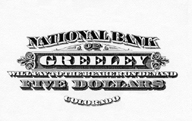
Greeley Colorado Banking History
and National Bank Notes
|
Schafluetzel's Home |
| Greeley History |
| Why NB notes issued |
| Greeley NB (#4437) |
| Union NB(#7604) |
| City NB(#10038) |
| Greeley Union NB(#4437) |
| Greeley NB (#13928) |
| First NB(#3178) |
| Greeley NB Summary |
| Bibliography |
Why National Bank Notes were Issued |
|
Following President Jackson's success in repealing the charter of the Second National Bank of the United States in 1836 the federal government removed itself from regulating the banking system. This left the states in charge of regulating banking. Thousands of banks printed and issued their own distinct banknotes, which invited counterfeiting. State laws and enforcement varied on the amount of currency that could be issued based on the bank assets. Frequent bank runs caused substantial depositors losses. As a result, banknotes were only accepted at face value near where the bank was located. Banknotes were discount more the farther it was from the issuing bank. Congress passed the National Banking Act of 1863 and 1864 for the purpose of financing the Civil War by encouraging banks to purchase U. S. Treasure bonds. A secondary purpose was to create a uniform national currency that would be accepted at par value through out the country. Congress accomplished this by creating federal chartered National Banks that allowed each bank to receive a uniform appearing National Bank Notes printed by the federal government with the local bank name, charter number and signatures on it. The National Banks were allowed to issue notes up to 90%, later 100%, of the value of the U. S. Treasure bonds they held. The National Banks were required to accept National Bank notes for other banks at par. U. S. Secretary of Treasure Samuel Chase, in the Lincoln administration, hoped the acts would encourage the state banks to convert to National Banks. By 1865 there were 1500 National Banks, 800 of which converted from state banks. However, the remaining state banks were still dominating the currency because the National Bank Notes were hoarded because they were not discounted. To further reduce the state banks, and the currency they generated, Congress imposed a 10% tax on all outstanding state banknotes. This effectively eliminated state banknotes. Three types of large size and one type of small size National Bank Notes were issued. The large size notes are known as First Charter, Second Charter and Third Charter National Bank Notes. First Charter notes were issued in 1, 2, 5, 10, 20, 50, 100, 500 and 1000 dollar denomination starting in 1863 The Second Charter Notes were issued in 5, 10, 20, 50 and 100 denominations starting in 1882. The Third Charter Notes were issued in the same denominations from 5 to 100 dollars starting in 1902. Small size National Bank Notes were also issued in the same denominations from 1929 to 1935. |